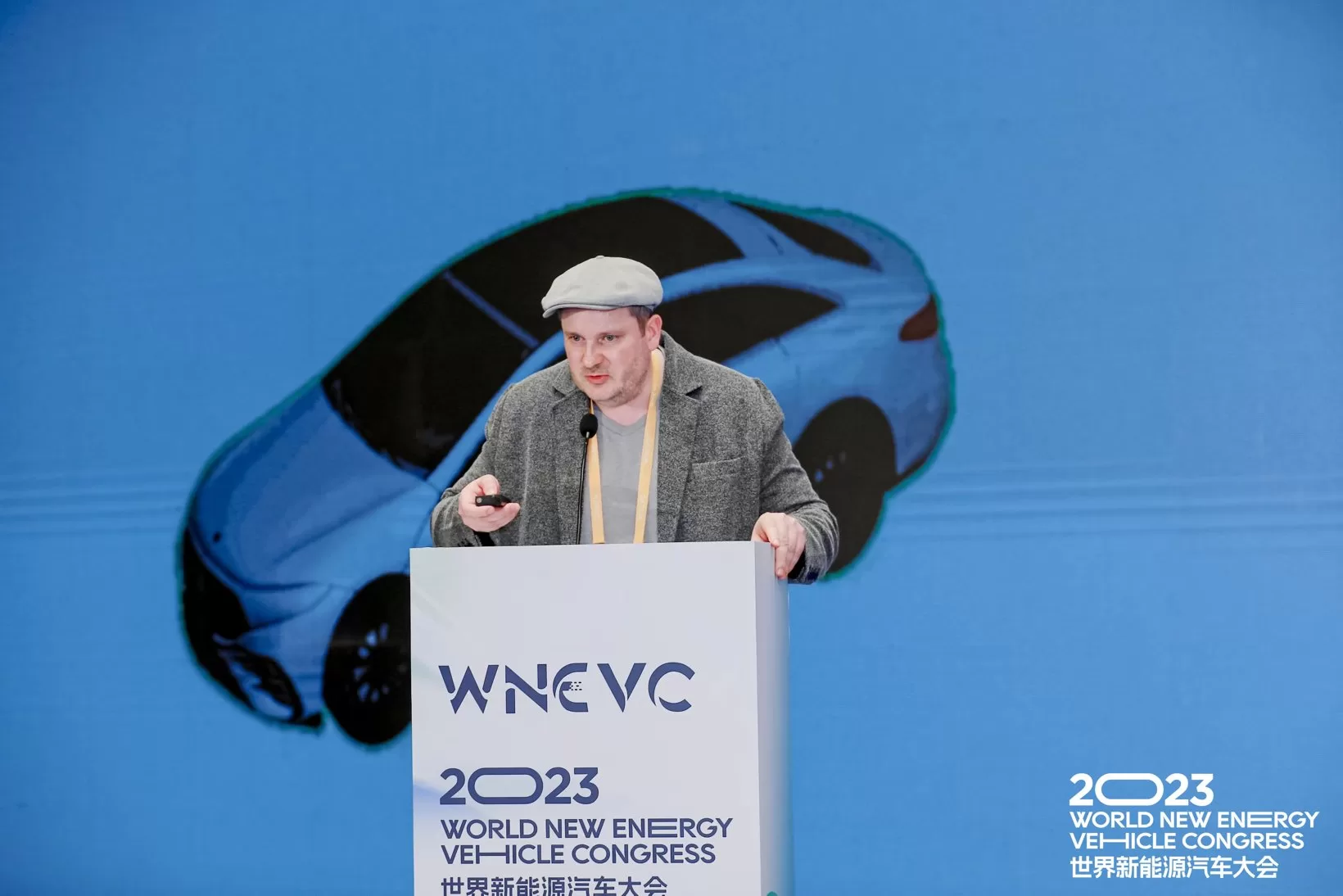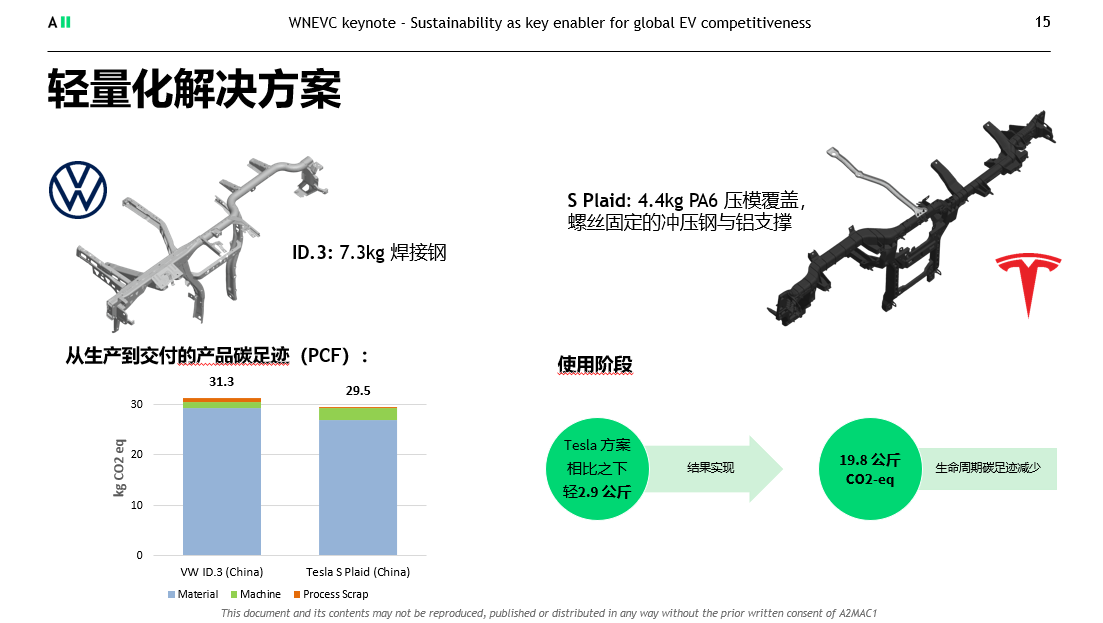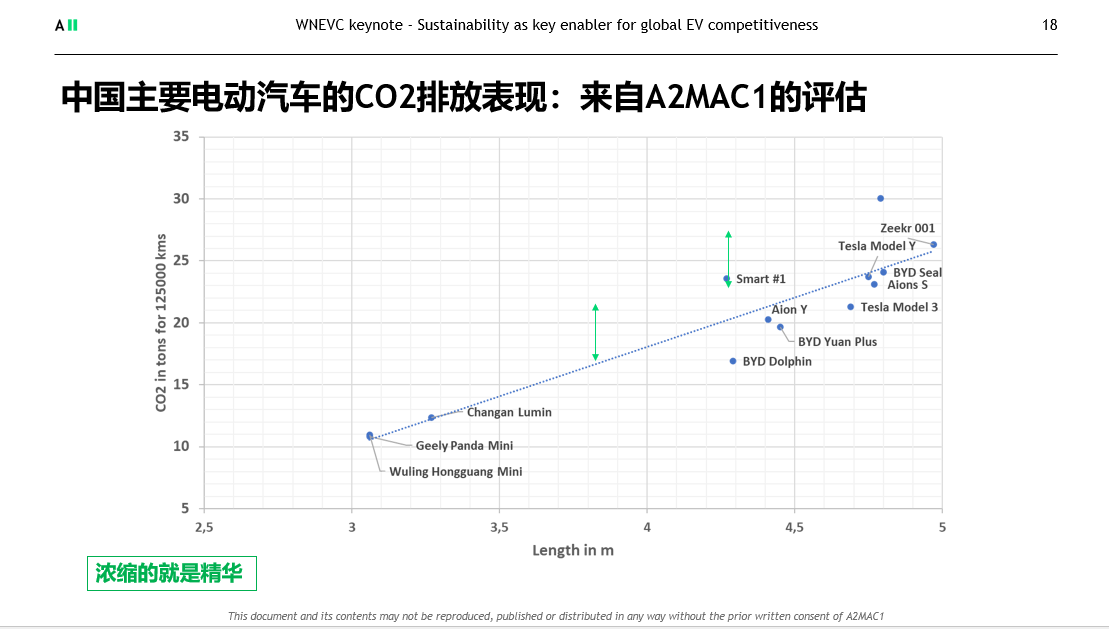“In the past, the performance and cost of cars were the top priority, but now, reducing carbon dioxide footprint has become a mandatory course for car companies under the push of multiple regulations,” said Arno Zinke, Chief Technology and Product Officer of A2MAC1, at the 2023 World New Energy Vehicle Congress.
A2MAC1’s Chief Technical and Product Officer Arno Zinke speaking at the World New Energy Vehicle Congress. Source: A2MAC1 The global push for electrification is aimed at reducing the carbon footprint of fuel-powered vehicles. Electric cars have become a focus of carbon footprint regulation by governments around the world. There is an urgent need for a unified and transparent method to assess the carbon footprint of vehicles on the market and to identify ways to reduce carbon emissions in the supply chain. After assessment, reducing the carbon footprint of cars has become a new challenge that the global automotive industry must address. Insight into carbon footprint calculation, A2MAC1 has a clever solution. In recent years, Europe has introduced several regulations to achieve the goal of carbon neutrality by 2050. Transportation, as a major source of carbon emissions, is a key focus area. In order to reduce carbon emissions from cars, the European Council approved a regulation in March of this year to ban the sale of new fuel-powered cars and small trucks that cause carbon emissions from 2035. In addition, France has linked subsidies for electric cars to their carbon footprint. The EU has announced that it will begin implementing a carbon border adjustment mechanism in 2026, and will require “battery passports” for power batteries exported to Europe from 2027, containing information on the manufacturer, material composition, carbon footprint, and supply chain.
A2MAC1’s Chief Technology and Product Officer, Arno Zinke, spoke at the World New Energy Vehicle Congress. Source: A2MAC1 Under strict regulations, calculating and evaluating the carbon footprint of vehicles is crucial. Determining the carbon footprint is the first step in reducing carbon emissions. How can a unified and transparent method be used to test and evaluate the carbon footprint of vehicles? As the first benchmark analysis company in the automotive industry, A2MAC1 has applied its years of benchmark analysis expertise to the testing and evaluation of vehicle carbon emissions. Detailed component scanning and analysis based on raw materials, production cycle, processes, and annual production volume can help car manufacturers find opportunities to optimize design, maximize performance, and reduce costs. It can also assess the carbon footprint of the entire lifecycle. At the 2023 World New Energy Vehicle Congress, Arno Zinke demonstrated the carbon emission analysis after dismantling the Volkswagen ID.3 and the Tesla Model S Plaid. For example, the dashboard crossbeam of the Volkswagen ID.3 uses 7.3kg of welded steel, while the Tesla Model S Plaid uses stamped steel and aluminum supports produced using a forming process, weighing only 4.4kg. Although the manufacturing process is more complex, A2MAC1’s calculations show that due to material characteristics and reduced process scrap, the overall carbon footprint of Tesla vehicles is lower.
Image source: A2MAC1 A2MAC1’s analysis also found that the air deflector in the Tesla Model S reduces drag and improves the vehicle’s range efficiency. The range increases by 1.5 kilometers with the same battery capacity, saving 255 Wh of energy for the same range and ultimately reducing the battery cost by $23 per vehicle, and also reducing carbon dioxide emissions by 53 kilograms. “This shows that seemingly small details can have a big impact. A small component can have a significant effect on the carbon footprint,” said Arno Zinke.
Image source: A2MAC1 A2MAC1 also presented a demonstration of electric vehicle carbon dioxide emissions analysis for several major Chinese automakers at the conference, with specific data shown in the following graph.
Image source: A2MAC1 The carbon emissions of electric vehicles in the image range from 10 to 30 tons, depending on the size of the vehicle. For example, smaller electric vehicles like the Wuling Hongguang Mini and the Geely Panda Mini have relatively lower carbon emissions. Aside from vehicle size and type, A2MAC1’s analysis also shows that electric vehicle emissions are closely related to factors such as battery capacity and supply chain localization, providing a breakthrough for automakers to reduce carbon emissions from electric vehicles. Usually, the process of tracking and evaluating carbon footprint and generating the above data insights is slow and cumbersome. A2MAC1 is committed to automating and integrating workflows to achieve rapid iteration, exploration of hypothetical scenarios, and cross-team collaboration. A recent example is the new cost accounting and sustainability solution based on A2MAC1’s knowledge base introduced by A2MAC1. This solution uses state-of-the-art technology modules and models to support various manufacturing processes, such as automatically calculating costs and carbon footprints, which can be applied to complete vehicles and components, significantly reducing turnaround time and ensuring the repeatability and consistency of results. Through A2MAC1’s technology, companies can not only quickly and comprehensively understand the carbon emissions of their own cars and parts, but also compare themselves with their competitors, play to their strengths and avoid weaknesses, and lay an important foundation for taking corresponding emission reduction measures in the future. Sustainable design reduces carbon footprint of cars from the source. Car design is a very important part of the entire car industry, and how to incorporate sustainability concepts into car design is the key to the success of the sustainable car industry in the future. With the rich experience and huge database accumulated in the field of benchmarking analysis of cars over the past few decades, as well as the service and evaluation platform created from this, A2MAC1 will be able to help car companies in both carbon footprint calculation and reduction. At this year’s World New Energy Vehicle Congress, Arno Zinke also introduced the best methods for designing more sustainable vehicles, and demonstrated the evolution of battery packs from Jikexi 001 to Jikexi 009 as an example. As shown, the 100 kWh battery installed in the Jike 001 uses standardized module battery pack technology, while the 140 kWh battery in the Jike 009 uses CTP technology, reducing or eliminating the space occupied by the battery module and reducing the cost of battery packaging by 16% compared to CTM.
Image source: A2MAC1 “According to A2MAC1 analysis, design changes can improve performance, reduce costs, and allow OEMs to build better products faster and with more confidence while maintaining the same external dimensions,” said Arno Zinke. Sustainable design of cars is influenced by various factors. One of them is the technological aspect, such as virtual products and digital twins, which can simulate real environments and test multiple concepts and solutions in a virtual environment to optimize the product. In addition, the application of AIGC on benchmark platforms allows customers to receive real-time feedback for faster product optimization. Another factor is the consideration of recycling and reusing car materials in the design phase. From vehicle development, raw material utilization, manufacturing to recycling, car manufacturers need to consider the reuse and recycling of cars after they are scrapped to minimize carbon emissions throughout the vehicle’s lifecycle. Furthermore, seamless collaboration and workflow synergy across different engineering disciplines through the interconnected digital platform can provide overall optimization insights for sustainable development. Arno Zinke stated that sustainable car design is such a huge engineering task that car manufacturers may not be able to fully focus on it. However, A2MAC1 is willing to “escort” manufacturers and has launched the CSS solution, which includes a tool, a database, and over 50 counting modules and models to support users’ cost estimation and sustainability optimization. Using the dashboard crossbeam of the Ford F 150 as an example, Arno Zinke demonstrated the impact of using recycled materials and supply chain on car carbon emissions at the World New Energy Congress. The left image shows the carbon emissions generated by using magnesium to manufacture the dashboard crossbeam in Mexico, while the middle image shows a 27% reduction in carbon dioxide emissions by using 40% recycled magnesium. Combining procurement with domestic production in the United States can achieve greener production and material reuse.
Image source: A2MAC1 By adopting sustainable materials, design, and technology, automotive manufacturers can reduce resource consumption, lower environmental pollution, and minimize waste generation from the outset. The sustainable development of future cars requires an interconnected ecosystem. The sustainable development of future cars is a global challenge, and achieving this goal requires efforts from all parties to build an interconnected ecosystem. “Competition does not apply to all issues. Different teams focus on solving the right problems and, through effective collaboration, can transform sustainability from a cost factor to a competitive advantage. To achieve this interconnected ecosystem, the automotive industry needs to optimize the overall system, including all indicators, for complete integration, and gain a 360-degree insight into the competitive landscape in order to stand out in fierce competition,” said Arno Zinke.
A2MAC1’s Chief Technical and Product Officer, Arno Zinke, spoke at the World New Energy Vehicle Conference roundtable forum. A2MAC1 provides a platform to connect traditional isolated industries at different stages of the manufacturing lifecycle, helping their customers produce the most cost-effective and environmentally friendly cars globally. Zinke said, “New carbon emission policies and regulations have brought many challenges to the development of new energy vehicles, but our future depends on whether we are willing to accept this challenge and optimize product development through a comprehensive approach to address environmental impact.”







